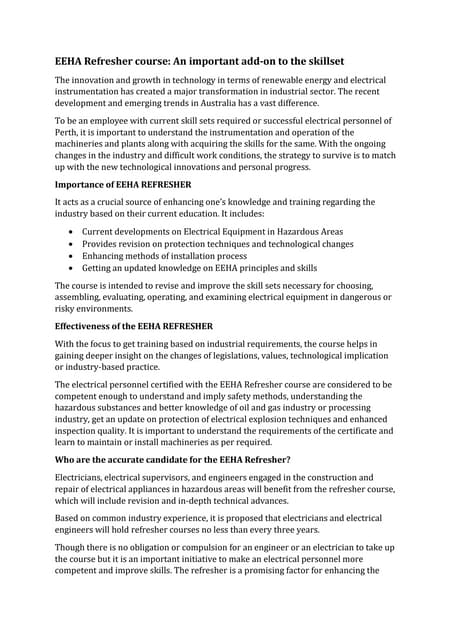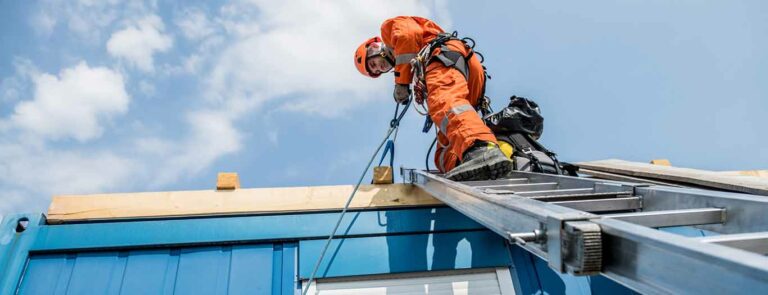Not known Facts About Roar Solutions
Wiki Article
Rumored Buzz on Roar Solutions
Table of ContentsThe smart Trick of Roar Solutions That Nobody is Talking About10 Easy Facts About Roar Solutions ShownRoar Solutions Things To Know Before You Buy
In order to secure setups from a potential surge an approach of evaluating and classifying a potentially dangerous area is required. The objective of this is to make certain the correct option and setup of equipment to inevitably stop a surge and to make certain security of life.
(https://www.abnewswire.com/companyname/training.roarsolution.com.au_152691.html#detail-tab)
No equipment should be installed where the surface temperature of the equipment is higher than the ignition temperature of the provided danger. Below are some typical dirt harmful and their minimal ignition temperature. Coal Dirt 380C 225C Polythene 420C (melts) Methyl Cellulose 420C 320C Starch 460C 435C Flour 490C 340C Sugar 490C 460C Grain Dirt 510C 300C Phenolic Resin 530C > 450C Aluminium 590C > 450C PVC 700C > 450C Soot 810C 570C The probability of the threat being existing in a concentration high sufficient to trigger an ignition will certainly differ from area to place.
Harmful location electrical tools maybe created for use in greater ambient temperature levels. Field Fixing By Authorised Worker: Complicated testing may not be needed nonetheless particular procedures may need to be adhered to in order for the equipment to maintain its 3rd celebration ranking. Each piece of tools with a harmful rating need to be assessed individually.
Not known Facts About Roar Solutions
The equipment register is an extensive database of devices records that includes a minimum collection of fields to identify each item's place, technological parameters, Ex classification, age, and environmental data. This information is vital for tracking and handling the tools efficiently within dangerous areas. In comparison, for periodic or RBI sampling evaluations, the quality will be a mix of In-depth and Close inspections. The proportion of In-depth to Close evaluations will certainly be determined by the Tools Danger, which is analyzed based upon ignition danger (the chance of a source of ignition versus the possibility of a combustible ambience )and the dangerous area classification( Area 0, 1, or 2). This variant will likewise affect the resourcing needs for job preparation. As soon as Whole lots are defined, you can create tasting plans based upon the sample dimension of each Lot, which refers to the variety of arbitrary equipment things to be evaluated. To establish the required example size, two elements need to be evaluated: the size of the Lot and the group of assessment, which suggests the level of effort that need to be used( reduced, typical, or raised )to the inspection of the Lot. By integrating the group of examination with the Great deal dimension, you can after that develop the suitable being rejected requirements for an example, implying the allowable number of defective items discovered within that example. For more information on this procedure, please describe the Power Institute Standards. The IEC 60079 conventional recommends that the optimum interval between assessments need to not surpass three years. EEHA evaluations will likewise be conducted outside of RBI projects as component of scheduled upkeep and tools overhauls or fixings. These assessments can be credited towards the RBI sample dimensions within the impacted Whole lots. EEHA evaluations are carried out to identify mistakes in electrical devices. A heavy racking up system is essential, as a single item of tools may have multiple mistakes, each with varying levels of ignition risk. If the consolidated score of both assessments is less than two times the fault score, the Great deal is regarded acceptable. If the Lot is still taken into consideration inappropriate, it needs to go through a complete examination or validation, which might set off stricter assessment procedures. Accepted Great deal: The root causes of any faults are determined. If a typical failing mode is located, added devices may call for maintenance. Mistakes are classified by severity( Safety, Integrity, House cleaning ), ensuring that immediate concerns are assessed and addressed quickly to minimize any influence on security or operations. The EEHA data source should track and tape-record the lifecycle of mistakes in addition to the restorative actions taken. Carrying out a robust Risk-Based Inspection( RBI )method is vital for guaranteeing compliance and safety and security in managing Electrical Tools in Hazardous Areas( EEHA) (electrical refresher course). Automated Fault Scoring and Lifecycle Monitoring: Easily take care of mistakes and track their lifecycle to improve examination accuracy. The introduction of this support for risk-based evaluation additionally reinforces Inspectivity's position as a best-in-class remedy for regulative compliance, in addition to for any type of asset-centric inspection use case. If you are interested in finding out more, we welcome you to request a presentation and find just how our service can transform your EEHA monitoring processes.
How Roar Solutions can Save You Time, Stress, and Money.

In regards to eruptive danger, a harmful location is a setting in which an explosive ambience exists (or may be anticipated to be present) in amounts that call for unique precautions for the construction, installment and use devices. eeha training. In this article we explore the difficulties faced in the work environment, the threat control steps, and the required expertises to work securely
These substances can, in specific conditions, create eruptive environments and these can have significant and awful effects. Many of us are familiar with the fire triangular get rid of any kind of one of the 3 elements and the fire can not occur, yet what does this mean in the context of unsafe areas?
In the majority of circumstances, we can do little about the degrees of oxygen airborne, yet we can have considerable impact on sources of ignition, as an example electrical equipment. Unsafe locations are recorded on the harmful location category illustration and are recognized on-site by the triangular "EX" indicator. Below, amongst other vital information, areas are divided right into three types depending on the risk, the possibility check this and period that an eruptive atmosphere will certainly exist; Zone 0 or 20 is considered one of the most dangerous and Zone 2 or 22 is regarded the least.
Report this wiki page